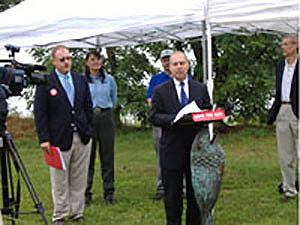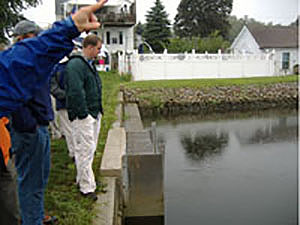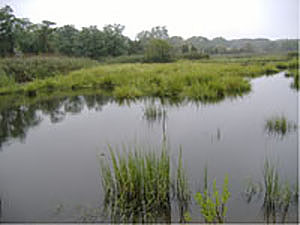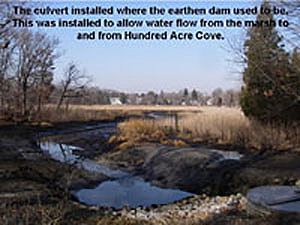
RI Coastal Resources Management Council
...to preserve, protect, develop, and restore coastal resources for all Rhode Islanders

...to preserve, protect, develop, and restore coastal resources for all Rhode Islanders
CRMC, Save The Bay, town, officials celebrate Walker Farm restoration
August 29, 2006, BARRINGTON—The Rhode Island Coastal Resources Management Council, project coordinator Save The Bay, the Town of Barrington, the National Oceanic and Atmospheric Administration, the USDA Natural Resources Conservation Service and other state agencies, non-profit groups and participants, celebrated the Walker Farm salt marsh restoration project with a public tour on Monday, Aug. 28 at Walker Farm in Barrington.
The salt marsh restoration project is a partnership of local, state and federal governmental partners, as well as non-governmental organizations working to return an historic salt marsh back to its original condition at Walker’s Farm Marsh. A major component of this project was the $30,000 funded by the CRMC through its Habitat Restoration Program and Trust Fund. The monies allocated through the Trust Fund were used to leverage $183,900 in matching federal funds (for a total of $213,900), without which this restoration project would not have been possible. To date the Trust Fund has provided monies to 25 habitat restoration projects throughout the state.
“The CRMC is proud to have been such a major part of the Walker Farm restoration project, through the Coastal and Estuarine Habitat Restoration Program and Trust Fund,” said CRMC Chairman Michael M. Tikoian. “Through this restoration, which will greatly reduce the Phragmites population, the marsh will be returned to its natural state and will increase in size to 24 acres. We applaud Save The Bay, the town and the other partners in their work on this project.”
Other partners include NOAA’s Restoration Center and Restore America’s Estuaries, Ducks Unlimited, Environmental Science Services, Inc., the Department of Environmental Management’s RUI Mosquito Abatement Program, the University of Rhode Island Department of Natural Resource Sciences and Vanasse Hangen Brustlin, Inc.
Walker Farm is part of the Hundred Acre Cove estuary in Upper Narragansett Bay. The marsh lies to the east of Route 114, the Wampanoag Trail. This 16-acre marsh includes salt marsh meadow, open water, mudflats, brackish marsh and Phragmites australis. The majority of the salt marsh is within the Osamequin Nature Sanctuary, owned by the Town of Barrington. The remaining section is adjacent to the town’s leaf composting area and community gardens. The southern tidal restriction is privately owned.
Historically, the Walker Farm was used for grazing livestock. Damns were built in the early 1900s to block tidal flows and facilitate the use of pastures. Dirt roads were built across the marsh to allow access to the farm. Salt water flow into the marsh is now restricted by a culverted dam, a culvert, two farm roads and an earthen dam at different points in the marsh.
The Coastal Habitat Restoration Team identified Walker Farm as one of 70 candidates for restoration in the state in 1999. The restoration project includes restoring tidal flow into the marsh, removing the farm roads to improve water flow and the modification of a water control structure at the northern end to prevent loss of the marsh with increased tidal flow.

Chairman Michael M. Tikoian speaks to a crowd at the Walker Farm event. At the left is Save The Bay Executive Director Curt Spalding.

One of the three new culverts installed to restore tidal flow to the marsh.

